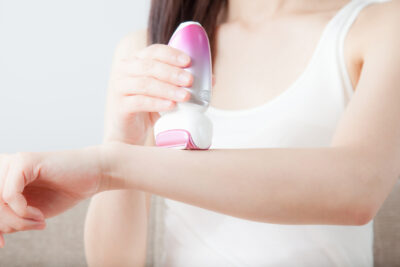Hirsutism
Hirsutism at a glance:
- Hirsutism is excessive growth of coarse hair on women in areas where it normally is minimal or nonexistent.
- Increased androgen hormone quantities or sensitivity to normal androgen hormone levels can cause the condition.
- Polycystic ovary syndrome (PCOS), a cause of infertility, is the most common cause of hirsutism.
- Hirsutism is a common disorder, affecting up to 10 percent of women in the United States.
- Not all causes of hirsutism are reversible, but the symptoms usually are manageable with medical and cosmetic treatments.
What is hirsutism?
 This is a condition in which a woman has increased coarse body hair in a pattern similar to that seen in men. The type of excessive hair is important. Increased quantities of soft hair are more suggestive of nonhormonal causes of hair growth, which can be seen more commonly in different ethnicities. While increased quantities of coarse and often dark hair, such as the hair seen in the pubic region, is more indicative of a hormonal cause of the hair growth.
This is a condition in which a woman has increased coarse body hair in a pattern similar to that seen in men. The type of excessive hair is important. Increased quantities of soft hair are more suggestive of nonhormonal causes of hair growth, which can be seen more commonly in different ethnicities. While increased quantities of coarse and often dark hair, such as the hair seen in the pubic region, is more indicative of a hormonal cause of the hair growth.
The face, back, midline chest, lower abdomen, inner thigh and buttocks are common areas where this occurs. Darkening of arm hair can also occur, making the hair look thicker.
Adults have two kinds of hair, vellus hair, which is usually soft, fine, short and colorless, and terminal hair, which is long, dark and coarse. Women have vellus hair on their face, arms, chest and back, with terminal hair usually isolated to the arm pits and the pubic region.
Men have terminal hairs throughout their body because they have androgen hormone levels far higher than the levels in females (usually 4-20 times higher). If a woman’s hair follicles become exposed to high androgen levels, or the follicles become more sensitive to normal androgen levels, her soft, vellus hairs can transform to become terminal hairs, a transformation known as hirsutism.
Hirsutism, from the Latin word hisutus meaning shaggy, rough & bristly, is a common disorder, affecting up to 10% of U.S. women, according to the American Society for Reproductive Medicine. It can be a symptom of polycystic ovary syndrome (PCOS), which can also be associated with infertility. In other cases, it can be an indication of a more serious medical problem with other hormone-producing organs.
Sometimes there’s no explanation for the condition, and it poses no other health risks. Regardless of the underlying cause, it often results in psychological or emotional distress, and therefore it is important to remember that the symptoms are treatable.
What causes hirsutism?
The condition is caused by increased androgen hormone levels or increased sensitivity of the hair follicles to androgen hormone levels. The most frequent androgen elevated is testosterone, but can also include dehydroepiandrosterone sulfate (DHEAS) and 17-hydroxyprogesterone (17-OHP).
In addition to PCOS, there are other causes and not all causes are reversible. However, symptoms are usually manageable with a combination of medical and cosmetic treatments.
It is crucial to understand the underlying cause of the condition, as this determines which method of treatment is appropriate. The causes of hirsutism generally fall into the following categories, and may be due to any combination of the three.
- Genetic: Women whose immediate family members experience symptoms of hirsutism are more likely to experience it themselves.
- Hormonal: High levels of androgen hormones can cause the condition. Additionally, low estrogen levels can cause it because estrogen helps the liver produce a protein that binds testosterone and prevents it from affecting the hair follicles. This is why women going through menopause often notice some increased facial hair. Some medications can also have an effect on the body’s natural balance of hormones.
- Underlying disorders: PCOS most often causes hirsutism. Other disorders such as Cushing’s syndrome, ovarian tumors and adrenal gland tumors are some of the more serious underlying issues that may cause hirsutism in a small number of cases. In severe cases, women can experience balding, an enlarging clitoris, deepening of the voice or loss of breast size. In these cases, a woman is said to have virilization. Virilization requires prompt medical evaluation to investigate the underlying cause.
- Obesity: Increased weight causes increased insulin production by the pancreas. Insulin stimulates the ovary cells to make testosterone, so increased insulin results in increased testosterone production that causes hirsutism. This can be related to PCOS, as many women that have PCOS also struggle with obesity. But not all obese women have PCOS.
How is hirsutism treated?
Symptoms usually are manageable with medical or cosmetic treatments, or a combination of the two. It is very important to remember the following points when considering treatment:
- Medical treatment decreases the transformation of new hair follicles changing from vellus to terminal hairs, but treatment cannot eliminate the terminal hairs that have already grown. Permanent hair removal treatments (laser and electrolysis) are the only methods to permanently kill a hair follicle to prevent that hair from regrowing.
- If cosmetic treatments alone are used, the hirsutism will never resolve, as the cosmetic treatments will remove the existing hair but will not block new hair from transforming into dark, coarse hair.
- The best strategy is aimed at removing existing hairs and doing something (either with medicine or lifestyle changes) to decrease the hormone imbalance internally to prevent the formation of new hair growth. Otherwise, cosmetic treatments will generally fail.
Treatments
- Estrogen and progesterone medications (often in the form of an oral contraceptive pill). Oral contraceptives cause an increase in the female hormones estrogen and progestin. Estrogen stimulates the liver to make a protein that binds testosterone, thereby decreasing the amount of testosterone that is exposed to the hair follicle. This can be a very effective treatment method for hirsutism, but can only be considered for women who are not seeking to become pregnant.
- Anti-androgen medication. Spironolactone, which blocks the body’s androgen receptors, may be prescribed. This is often used with an estrogen containing oral contraceptive pill and can increase the effectiveness of the treatment. This treatment method should not be used by pregnant women or those seeking to actively become pregnant, as anti-androgen medication can cause birth defects. If pregnancy is desired in the future, these medications can be safely used with a reliable form of contraception, and then stopped when pregnancy is desired.
- Weight loss. Dropping excess pounds will often result in a reduction of insulin, which, as outlined above, will decrease the ovarian production of testosterone and decrease hair growth over time.
- Topical treatment. Prescription cream that slows hair growth may be recommended (eflornithine, brand name Vaniqa).
- At-home hair removal. Many women are able to successfully manage unwanted hair growth using waxing, bleaching, plucking or shaving.
- Permanent hair removal procedures. Some women opt for permanent hair removal procedures such as electrolysis or laser hair removal.
Risks and complications of treatments
It is important that women affected by hirsuitism talk to their doctor before beginning treatment so that the risks, benefits and side effects of treatments can be fully explained. Risks can include:
- Side effects from oral contraceptive pills, which include nausea, water retention and a small increase in risk of blood clots.
- Anti-androgen medication may cause drowsiness, lightheadedness, nausea or vomitting
- At-home hair removal can sometimes cause unwanted side effects such as razor burn, ingrown hairs and pain.


